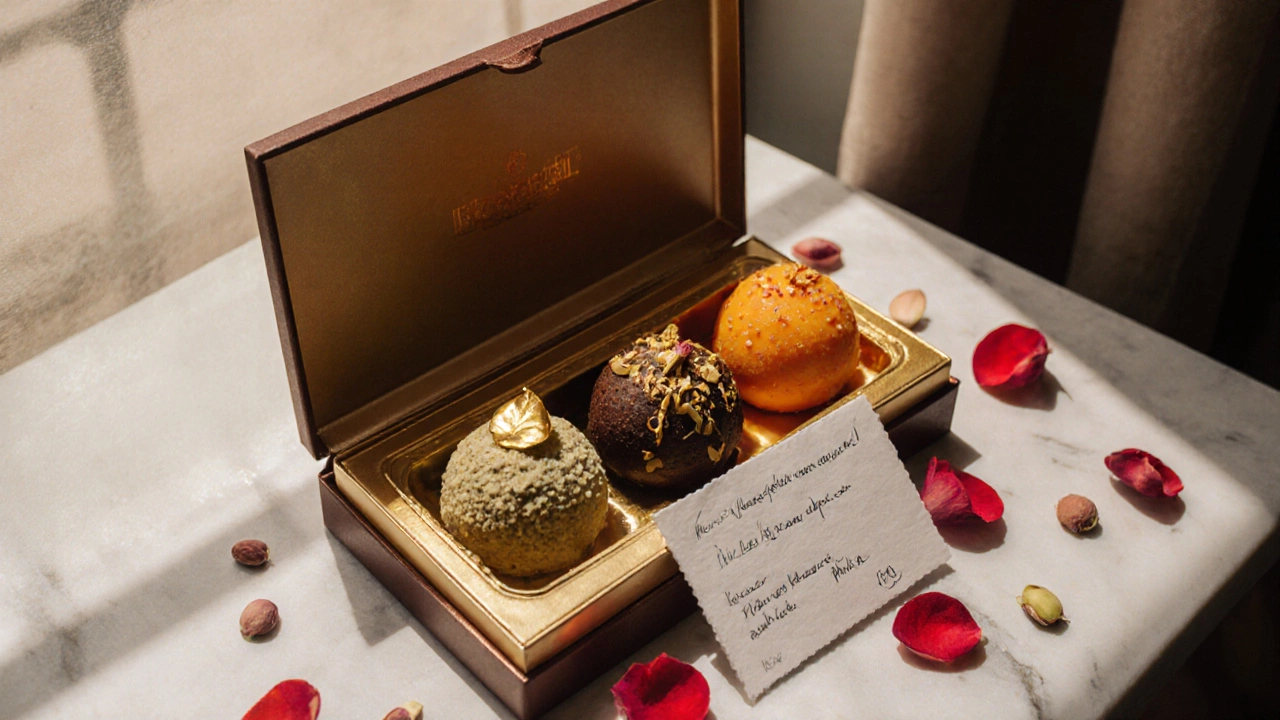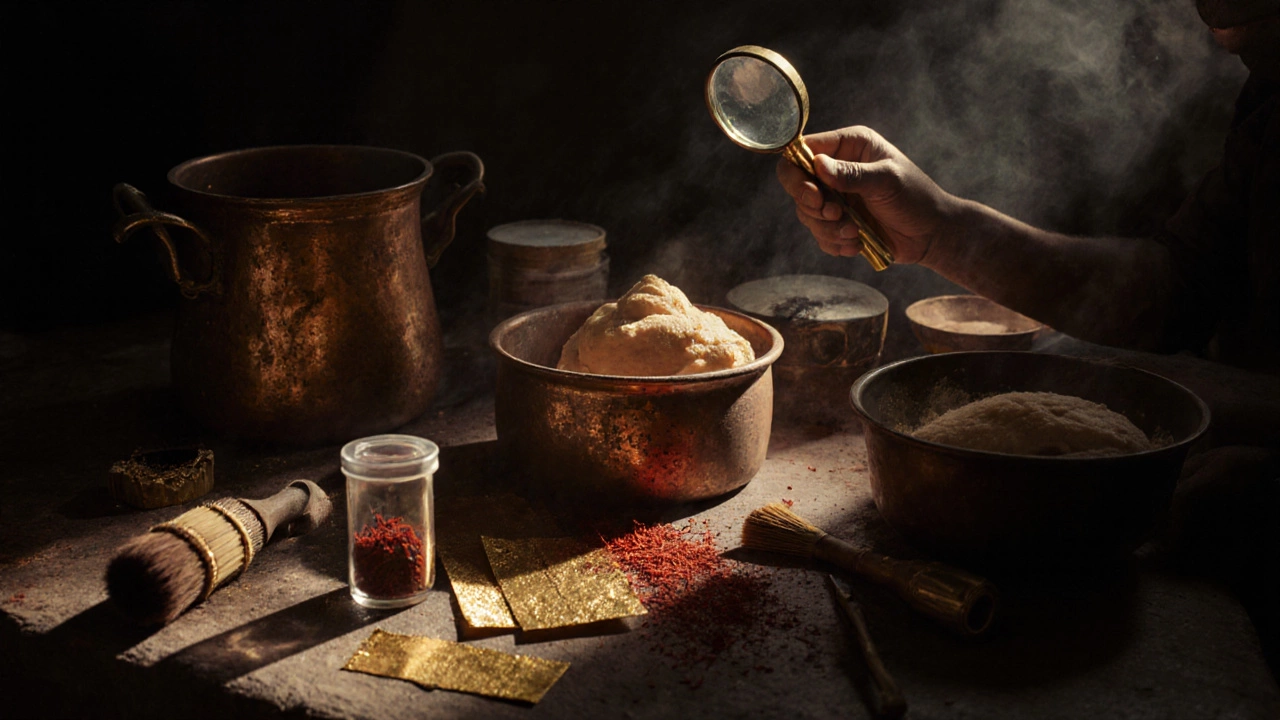Gold Laddoo Cost Calculator
Calculate Your Gold Laddoo Cost
Cost Breakdown
Estimated Total Cost
Compare with Regular Sweets
How This Works
Gold Cost: Your calculation based on current gold prices (₹0).
Other Ingredients: Fixed cost of ₹70,000 for premium saffron, ghee, and khoya.
Total: Gold cost + ₹70,000 for the complete laddoo.
Note: The ₹2.5 lakh version uses 1.5g of edible gold. Gold prices fluctuate daily, so your calculation may vary.
When you think of Indian sweets, you picture jalebis dripping in syrup, gulab jamuns soaking in cardamom sugar water, or barfis stacked in colorful trays. But there’s one sweet that doesn’t just cost more-it costs thousands of rupees. Not because it’s rare, but because it’s made with ingredients you’d normally find in a jewelry box.
The Sweet That Costs More Than a Laptop
The most expensive Indian sweet is the Moti Chur Laddoo wrapped in 24-karat edible gold leaf, made by a confectioner in Jaipur. It’s not just a dessert. It’s a statement. One piece, weighing about 150 grams, sells for ₹2.5 lakh (roughly $3,000 USD). That’s more than a mid-range smartphone, a month’s rent in many Indian cities, or a full week’s groceries for a family of four.What makes it so pricey? It’s not the flour or sugar. It’s the gold. Each laddoo uses 1.5 grams of pure edible gold foil, hand-applied by artisans trained for years. The gold isn’t just decorative-it’s food-grade, certified by the FSSAI, and safe to eat. The cost of that gold alone runs over ₹1.8 lakh. The rest? Premium saffron from Kashmir, pure ghee from desi cows, and sugar crystals aged for six months to achieve the perfect texture.
Why Gold? Why Now?
Gold in sweets isn’t new. Mughal royalty used to sprinkle gold dust on desserts during weddings and festivals. But today’s version is different. It’s not about tradition-it’s about status. In cities like Mumbai, Delhi, and Hyderabad, corporate gifting has turned luxury sweets into business cards. A CEO gives a gold-laced laddoo to a client not to sweeten the deal-but to show they can afford to.Companies like Haldiram’s and Bikanervala now offer gold-leaf sweets as premium gifts. But the Jaipur-based Shree Balaji Sweets is the only one that sells the ₹2.5 lakh version regularly. They make fewer than 50 per month. Each one is handcrafted over three days. The sugar is boiled, cooled, and kneaded by hand. The saffron is soaked in rosewater for 12 hours. The gold leaf is applied with a camel-hair brush. No machines. No shortcuts.

What Else Makes Indian Sweets Expensive?
Gold laddoos aren’t the only costly sweets. Here are a few others that come close:- Kesar Peda made with 100 grams of Kashmiri saffron per kilo-costs ₹8,000-₹12,000 per kg. That’s because one gram of top-grade saffron costs ₹300-₹500. It takes 150,000 crocus flowers to make one kilo of saffron.
- Phirni with real pistachios from Afghanistan-₹5,000 per kg. Afghan pistachios are richer, larger, and less bitter than Iranian ones. Import duties and shipping push the price up.
- Barfi made with khoya from grass-fed cows in Uttarakhand-₹6,000 per kg. The milk is boiled for 12 hours to reduce it to 10% of its volume. Only 200 grams of khoya comes from 2 liters of milk.
These aren’t just desserts. They’re time capsules. Each ingredient carries a story-of farmers, harvests, labor, and patience. A single laddoo can take 48 hours to make. That’s not inefficiency. That’s craftsmanship.
Is It Worth It?
If you’re asking whether the taste justifies the price, the answer is… no. Not really.Gold has no flavor. Saffron gives it a floral, earthy note, but if you’ve had a good kesar peda without gold, you’ll know the difference isn’t in taste-it’s in perception. The gold laddoo is an experience. It’s the crunch of sugar under your teeth, the warmth of ghee, the faint aroma of cardamom-and then, the realization that you’re eating something so rare, so expensive, it’s almost impossible to believe.
People buy it for three reasons:
- To impress someone-weddings, corporate gifts, VIP visits
- To honor tradition-some families serve it at ancestral rituals
- To own a piece of luxury-like buying a limited-edition watch
There’s no nutritional benefit. No health claim. It’s not vegan, not gluten-free, not low-sugar. It’s pure indulgence. And that’s exactly why it exists.

How to Spot a Fake Gold Sweet
With demand rising, so do fakes. Some sellers use aluminum foil dyed gold. Others skip the saffron and use artificial color. Here’s how to tell:- Check the gold: Real edible gold is thin, brittle, and flakes easily. It doesn’t peel off in sheets. If it looks like plastic wrap, it’s fake.
- Smell the saffron: Real saffron smells like hay and honey. Artificial flavor smells chemical, like plastic or perfume.
- Ask for certification: Reputable makers show FSSAI certification for edible gold. Ask for it.
- Price check: If a gold laddoo costs under ₹5,000, it’s not real. The gold alone costs more than that.
What’s Next for Luxury Sweets?
The trend is spreading. In Dubai, Indian sweet shops now sell laddoos with edible platinum. In Singapore, they’re experimenting with truffle-infused barfis. In India, young entrepreneurs are launching blockchain-certified sweets-each laddoo comes with a digital certificate showing the origin of every ingredient.But the original gold laddoo from Jaipur still holds the crown. It’s not the flashiest. It’s not the most marketed. But it’s the one with the longest history, the most labor, and the most integrity.
So, is it the costliest? Yes. Is it the best? That’s up to you. But if you ever get the chance to taste one-don’t just eat it. Savor it. Because you’re not just eating a sweet. You’re tasting a piece of culture, history, and human effort that few will ever afford-or even understand.
Is edible gold safe to eat?
Yes, edible gold is completely safe. It’s made of 24-karat pure gold, approved by food safety authorities like the FSSAI in India and the FDA in the U.S. Gold is chemically inert, meaning it doesn’t react with your body. It passes through your system unchanged and is excreted without being absorbed. No health benefits, no side effects-just a shiny, expensive decoration.
Can I make a gold laddoo at home?
Technically, yes-but it’s not practical. You’d need 1.5 grams of food-grade gold foil (costing ₹1.5-₹1.8 lakh), pure Kashmiri saffron (₹10,000+), and high-quality khoya. The process takes three full days, requires precise temperature control, and skilled hand-kneading. Most home kitchens don’t have the tools or patience. It’s cheaper and easier to buy one from a trusted maker than to try making it yourself.
Are there cheaper alternatives with similar luxury appeal?
Yes. Look for sweets made with premium ingredients instead of gold. A kesar peda with 50 grams of real saffron per kg costs around ₹8,000 and delivers the same rich flavor. Or try a barfi made with Afghan pistachios and organic ghee. These offer luxury without the gold-and still cost less than 10% of the top-tier laddoo.
Why is saffron so expensive in Indian sweets?
Saffron comes from the stigma of the crocus flower, and it takes about 150,000 flowers to make one kilogram. Each stigma is picked by hand at dawn, before the sun rises. Kashmir produces the best saffron, but labor costs and climate risks make supply unstable. Top-grade saffron costs ₹300-₹500 per gram. That’s why even small amounts in sweets drive up the price dramatically.
Where can I buy the real gold laddoo?
The original ₹2.5 lakh Moti Chur Laddoo is made by Shree Balaji Sweets in Jaipur. They ship across India and internationally. You can order through their website or visit their shop in the old city. Avoid third-party sellers on Amazon or Flipkart-most gold sweets sold there are fake or use low-grade foil. Always ask for the maker’s name and certification.

